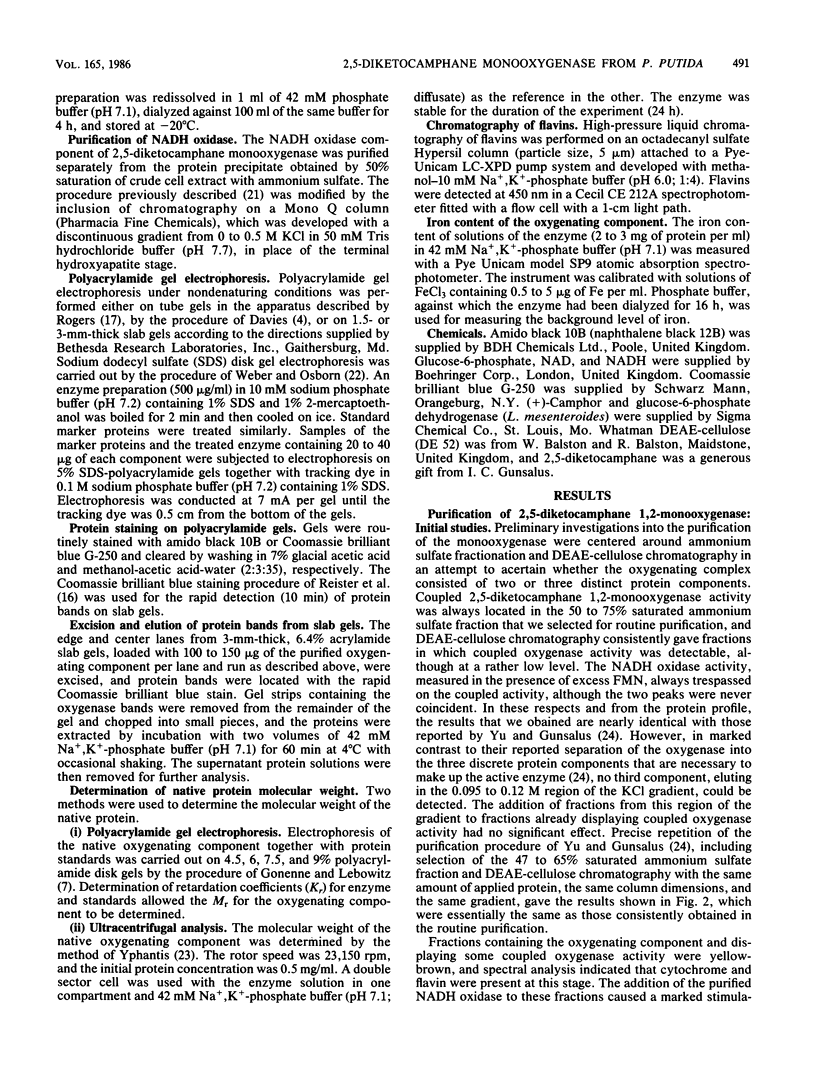Abstract
The oxygenating component of 2,5-diketocamphane 1,2-monooxygenase from Pseudomonas putida ATCC 17453 was purified to homogeneity by a combination of ammonium sulfate fractionation and chromatography on DEAE-cellulose and polyanion SI-17 columns. It had an Mr of 78,000, bound one molecule of nonautooxidizable flavin mononucleotide (FMN), consisted of two subunits of equal molecular weight, and existed in two electrophoretically distinguishable active forms. The oxygenating complex was constructed from equimolecular amounts of an NADH oxidase, which could be purified separately (Mr, 36,000), and the oxygenating component. Most of the NADH oxidase dissociated from the oxygenating component during purification, although traces remained, to give the final preparation of the oxygenating component significant oxygenase activity. FMN did not dissociate significantly from the oxygenating component during purification, but it was not covalently bound and could be removed under a variety of conditions. Binding between the two proteins that made up the active complex was fairly weak and freely reversible. It probably occurred through the FMN which was strongly bound to the oxygenating component and for which the NADH had a weak binding site. Iron was not present at a significant level in the oxygenating component, and in common with other characterized Baeyer Villiger monooxygenases, 2,5-diketocamphane 1,2-monooxygenase was found to be a simple flavoprotein.
Full text
PDF








Images in this article
Selected References
These references are in PubMed. This may not be the complete list of references from this article.
- CONRAD H. E., DUBUS R., GUNSALUS I. C. An enzyme system for cyclic ketone lactonization. Biochem Biophys Res Commun. 1961 Nov 29;6:293–297. doi: 10.1016/0006-291x(61)90382-5. [DOI] [PubMed] [Google Scholar]
- CONRAD H. E., DUBUS R., NAMTVEDT M. J., GUNSALUS I. C. MIXED FUNCTION OXIDATION. II. SEPARATION AND PROPERTIES OF THE ENZYMES CATALYZING CAMPHOR LACTONIZATION. J Biol Chem. 1965 Jan;240:495–503. [PubMed] [Google Scholar]
- Conrad H. E., Lieb K., Gunsalus I. C. Mixed function oxidation. 3. An electron transport complex in camphor ketolactonization. J Biol Chem. 1965 Oct;240(10):4029–4037. [PubMed] [Google Scholar]
- DAVIS B. J. DISC ELECTROPHORESIS. II. METHOD AND APPLICATION TO HUMAN SERUM PROTEINS. Ann N Y Acad Sci. 1964 Dec 28;121:404–427. doi: 10.1111/j.1749-6632.1964.tb14213.x. [DOI] [PubMed] [Google Scholar]
- Donoghue N. A., Norris D. B., Trudgill P. W. The purification and properties of cyclohexanone oxygenase from Nocardia globerula CL1 and Acinetobacter NCIB 9871. Eur J Biochem. 1976 Mar 16;63(1):175–192. doi: 10.1111/j.1432-1033.1976.tb10220.x. [DOI] [PubMed] [Google Scholar]
- Donoghue N. A., Trudgill P. W. The metabolism of cyclohexanol by Acinetobacter NCIB 9871. Eur J Biochem. 1975 Dec 1;60(1):1–7. doi: 10.1111/j.1432-1033.1975.tb20968.x. [DOI] [PubMed] [Google Scholar]
- Gonenne A., Lebowitz J. Estimation of molecular weights of small proteins on polyacrylamide gel electrophoresis. Anal Biochem. 1975 Apr;64(2):414–424. doi: 10.1016/0003-2697(75)90449-2. [DOI] [PubMed] [Google Scholar]
- Griffin M., Trudgill P. W. Purification and properties of cyclopentanone oxygenase of Pseudomonas NCIB 9872. Eur J Biochem. 1976 Mar 16;63(1):199–209. doi: 10.1111/j.1432-1033.1976.tb10222.x. [DOI] [PubMed] [Google Scholar]
- McIntire W., Singer T. P. Resolution of p-cresol methylhydroxylase into catalytically active subunits and reconstitution of the flavocytochrome. FEBS Lett. 1982 Jul 5;143(2):316–318. doi: 10.1016/0014-5793(82)80124-5. [DOI] [PubMed] [Google Scholar]
- Ougham H. J., Taylor D. G., Trudgill P. W. Camphor revisited: involvement of a unique monooxygenase in metabolism of 2-oxo-delta 3-4,5,5-trimethylcyclopentenylacetic acid by Pseudomonas putida. J Bacteriol. 1983 Jan;153(1):140–152. doi: 10.1128/jb.153.1.140-152.1983. [DOI] [PMC free article] [PubMed] [Google Scholar]
- ROGERS L. J. A SIMPLE APPARATUS FOR DISC ELECTROPHORESIS. Biochim Biophys Acta. 1965 Mar 29;94:324–329. doi: 10.1016/0926-6585(65)90041-5. [DOI] [PubMed] [Google Scholar]
- ROSENBERGER R. F., ELSDEN S. R. The yields of Streptococcus faecalis grown in continuous culture. J Gen Microbiol. 1960 Jun;22:726–739. doi: 10.1099/00221287-22-3-726. [DOI] [PubMed] [Google Scholar]
- Reisner A. H., Nemes P., Bucholtz C. The use of Coomassie Brilliant Blue G250 perchloric acid solution for staining in electrophoresis and isoelectric focusing on polyacrylamide gels. Anal Biochem. 1975 Apr;64(2):509–516. doi: 10.1016/0003-2697(75)90461-3. [DOI] [PubMed] [Google Scholar]
- Ryerson C. C., Ballou D. P., Walsh C. Mechanistic studies on cyclohexanone oxygenase. Biochemistry. 1982 May 25;21(11):2644–2655. doi: 10.1021/bi00540a011. [DOI] [PubMed] [Google Scholar]
- Trudgill P. W., DuBus R., Gunsalus I. C. Mixed function oxidation. V. Flavin interaction with a reduced diphosphopyridine nucleotide dehydrogenase, one of the enzymes participating in camphor lactonization. J Biol Chem. 1966 Mar 10;241(5):1194–1205. [PubMed] [Google Scholar]
- YPHANTIS D. A. EQUILIBRIUM ULTRACENTRIFUGATION OF DILUTE SOLUTIONS. Biochemistry. 1964 Mar;3:297–317. doi: 10.1021/bi00891a003. [DOI] [PubMed] [Google Scholar]
- Yu C. A., Gunsalus I. C. Monoxygenases. VII. Camphor ketolactonase I and the role of three protein components. J Biol Chem. 1969 Nov 25;244(22):6149–6152. [PubMed] [Google Scholar]



